In what leaders are comparing to “airline code share partners,” three major construction owner organizations—the Construction Industry Institute, the Construction Users Roundtable and the Engineering and Construction Contracting Association—announced Sept. 23 their intention to form an alliance to provide more resources and reduce overall costs to members, many of whom belong to all three groups.
In an exclusive group interview with ENR and leaders of the three groups, Tony Bazzini, chair of the ECC Association and chief engineer of ExxonMobil Global Projects Co., says Exxon is among the 40% of members who are active in all three groups. “There’s a tremendous value proposition to leverage the groups’ different focus areas, and we believe synergies will result,” Bazzini says. ECC focuses on leadership development, networking and outreach, CII drives innovation through research, and CURT provides product development and resource alignment.
Collectively, the three groups together have close to 300 member organizations, and the alliance will add breadth across industry sectors. Members include large corporations including DuPont, General Motors and Google; government builders such as the U.S. Army Corps of Engineers and the General Services Administration; and construction industry associations, engineers and contractors. ECC has roots in the oil and gas sector and “we’ve been striving to increase our diversity of industry segments for quite a while,” Bazzini says. The alliance will expose companies in other industry sectors “to what we have to offer.”
Stephen Mulva, director of the Construction Industry Institute, says member companies are “challenged” on time and resources to participate in multiple organizations and this is a way to “achieve critical mass—to drive the improvements they are seeking but to do it in an efficient way for them.” The alliance is in response to feedback from members and sponsors suggesting that the groups work together, Mulva adds.
The effort is not a merger, the leaders stress, calling it instead a “coordinated approach to problem-solving.” Greg Sizemore, executive vice president of CURT, emphasizes that the word alliance was chosen carefully and echoes airline alliances, such as the Sky Team Alliance, which brings together multiple airlines to offer expanded joint services. As with the airline alliance, the construction industry groups will retain their own identities and manage their own interests but also commit to a more coordinated effort that might create a more "favorable pricing structure," he says.
Details to Come
The memo forming the alliance creates a 12-member team—four members from each group —that will explore creating a board of advisors, joint alliance dues, rolling together duplicate activities, colocating conferences, and what the alliance should be named.
The alliance is not a direct result of the COVID pandemic and the economic downturn. “We’ve been talking about this over several years,” Sizemore says, but “COVID provided a little bit of a rocket booster to this.”
Each organization has advantages and limitations—advantages that the others don't have and limitations internally, providing some real opportunities, Sizemore explains. “Some things that CII, based at University of Texas, can’t do, CURT can do, for example, and ECC has some program strengths that CURT doesn’t have—it’s very compelling,” he says.
One of the trickiest questions is whether the alliance could eventually involve more groups than the initial three organizations. “We don’t want to be exclusive, we want to be as inclusive as possible,” Sizemore says, “but we’re trying to understand what that means.” As a practical matter initially the group will start with the three organizations.
Bazzini adds that making the effort broad over the long run will drive innovation and success. He sees a need for technology and transformational leadership to help improve the efficiency of project delivery and risk transparency, and, perhaps most important, for all the players on the construction team to “win” at the end of a job. This is the best way the industry can remain strong financially and “be successful for the owners and customers that we are doing business with,” he says.






Post a comment to this article
Report Abusive Comment